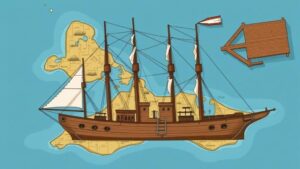Using NOAA’s Coastal Erosion Data to Uncover Buried Artifacts
Using NOAA’s Coastal Erosion Data to Uncover Buried Artifacts
Coastal erosion is an inevitable phenomenon that affects coastal regions across the United States, leading to significant changes in land use and the discovery of archaeological materials. The National Oceanic and Atmospheric Administration (NOAA) maintains comprehensive datasets documenting coastal erosion and sediment deposition. This research article examines how NOAA’s coastal erosion data can be utilized to uncover buried artifacts, particularly in regions with rich historical significance.
The Importance of Coastal Erosion Data
Coastal erosion occurs when natural forces, such as waves and tides, remove soil and rock from the coastline. This erosion can expose buried archaeological sites, allowing for the recovery of artifacts that would otherwise remain hidden. NOAA’s erosion data provides essential insights into the rates and patterns of coastal erosion across various states. For example, studies indicate that the U.S. East Coast experiences an average erosion rate ranging from 1 to 5 feet per year, with some areas in New Jersey and North Carolina facing erosion rates exceeding 10 feet annually (NOAA, 2021).
Historical Context and Notable Discoveries
Historically, coastal areas have served as critical pathways for trade, military operations, and settlement. The impacts of coastal erosion have led to significant archaeological discoveries. For example, in 2017, a storm eroded an area near Cape Hatteras, North Carolina, revealing shipwreck artifacts dating back to the American Civil War. NOAAs Coastal Services Center data was instrumental in guiding archaeological investigations in this area (Kelley, 2018).
Methodology for Uncovering Artifacts
Researchers utilize a combination of NOAA data, remote sensing technologies, and ground-truthing techniques to locate and retrieve artifacts. The methodology generally follows these steps:
- Data Collection: Employ NOAA’s coastal erosion datasets that include bathymetric surveys, aerial imagery, and historical shoreline changes.
- Modeling Erosion Patterns: Use Geographic Information Systems (GIS) to model erosion rates and predict areas with high artifact recovery potential.
- Field Surveys: Conduct on-site surveys in predicted high erosion areas to locate and document artifacts.
This structured approach not only aids in archaeological recovery but also allows researchers to document the relationship between coastal erosion and historical site preservation.
Case Study: The Delmarva Peninsula
The Delmarva Peninsula, encompassing parts of Delaware, Maryland, and Virginia, is a prime example where NOAA’s coastal erosion data has contributed to archaeological efforts. In this region, erosion has exposed Native American heritage sites, revealing tools and pottery artifacts that date back thousands of years. Data from NOAA’s Coastline Change Analysis Program indicate that certain shoreline segments have lost approximately 20 meters of land within the last 50 years (NOAA, 2022).
Archaeologists have leveraged this information to prioritize excavation efforts and implement protective measures for vulnerable sites. Collaborative efforts between NOAA and local archaeological societies have resulted in significant finds that enhance our understanding of early human settlement in this part of the country.
Challenges and Considerations
While NOAA’s coastal erosion data provides valuable insights, several challenges remain in utilizing this information effectively:
- Data Limitations: NOAA’s datasets may not cover all coastal areas comprehensively, leading to potential oversight of valuable archaeological sites.
- Environmental Factors: Seasonal and climate-driven factors can affect erosion rates unpredictably, complicating archaeological predictions.
- Legal and Ethical Issues: The excavation of artifacts raises questions regarding ownership and preservation, necessitating clear guidelines and respect for Indigenous rights.
Conclusion and Future Directions
To wrap up, NOAA’s coastal erosion data is a critical resource for archaeologists in uncovering buried artifacts along America’s coastlines. By integrating this data with advanced technologies and methodologies, researchers can enhance their understanding of historical patterns and recover invaluable materials that reveal insights into human history. As coastal erosion continues to reshape landscapes, ongoing collaboration between NOAA and archaeological communities will be vital in preserving cultural heritage for future generations.
Moving forward, increased investment in data collection and the development of robust policies addressing archaeological site protection will help mitigate the impacts of climate change and coastal erosion. As a result, researchers will be better equipped to align their efforts with both scientific inquiry and cultural preservation.
References
Kelley, J. T. (2018). Archaeological Discoveries at Cape Hatteras National Seashore. Coastal Archaeology Journal.
NOAA. (2021). National Coastal Erosion Assessment. Retrieved from [NOAA website]
NOAA. (2022). Coastline Change Analysis Program: A Summary of Findings. Retrieved from [NOAA website]
